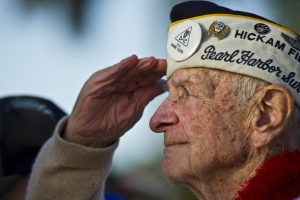13 Chapter 10: Feature Stories
Feature Writing

Filmmaker Andrew Stanton (“Toy Story,” “WALL-E”) gave a TED Talk in 2011 about storytelling. He told the audience: “Storytelling is joke telling. It’s knowing your punchline. Your ending. Knowing that everything you’re saying, from the first sentence to the last, is leading to a singular goal and ideally confirming some truth that deepens our understandings of who we are as human beings.”
Storytelling is a crucial tool used in feature stories. Feature stories are news stories with a storytelling focus. They are still full of verified facts and information, but they often include more narrative and anecdotes and human elements. They are still objective and written in the third person.
Like news stories, feature stories need to tell the reader something new. Stanton summed it up nicely in his TED Talk:
“Make me care. Emotionally, intellectually, aesthetically. In the beginning, make a promise to your audience that this story will lead somewhere that’s worth their time.”
Feature stories are your chocolate news. They are written in the same manner as news stories with leads, nut grafs and fact-based endings. But they are often more fun to consume. They are more likely to have alternative leads, but the newsworthiness is always paramount.
Feature stories allow for more narrative writing and descriptions, but good feature writers know that their readers might still leave if the story drags. In feature stories, like with news stories, you need to be stingy with your words, sentences and paragraphs. Every word should enhance the story to keep readers engaged.
Feature Characteristics
Writing expert Roy Peter Clark delves into feature stories in a 2004 article for Poynter.
“Readers like stories, even news stories, written in ‘feature style,’ ” Clark writes. “And since the invention of the human-interest story, the feature has had the beneficial effect of expanding the universe of newspaper readers while enriching our definition of news.”
Clark goes on to list possible characteristics of a feature story:
- You can read it in a single sitting on the day it was published.
- You can read a short one in five minutes and a long one in 15 minutes.
- It is NOT a news story but can be inspired by the news.
- It has, at its heart, human interest.
- It illuminates lives lived in our time.
- It takes advantage of an expanded set of language and narrative strategies.
- It can be written and reported within the normal timeframe of journalistic enterprise.
Another Poynter expert, Butch Ward, writes about the importance of details in a feature story. He emphasizes the importance of the reporter being in the middle of the story when possible. He writes that a “keen observation allows the writer to speak with authority” and points to examples of reporters who are there to hear sirens or see children play and describe that from their own observations.
Ward also advises feature writers to carefully choose what details go into their story: “Show me instead of telling me. When I read ‘the security guards did not stir from their cigarettes and tea,’ I not only know something about the guards; I see them relaxing – because that’s what you do with a cup of tea and a smoke.”
Lastly, Ward writes that all sizes of feature stories have details. Even social media posts can be specific enough to put the reader in a particular place. Details humanize your sources and get the readers vested in the outcome.
Eight Types of Feature Stories
Profile or Personality Feature

A profile or personality feature is an objective news story about a person.
A Jan. 30, 2022 profile feature story by the Washington Post’s Eli Saslow was one of four that won the journalist the Pulitzer Prize in feature writing. In Saslow’s story about a billionaire, the reader gets a glimpse into his life. The story chronicles the billionaire’s long hours at his desk watching his money, the size of his wife’s closet and the fact that he has never swum in his own infinity pool. This level of detail comes from comprehensive reporting.
Saslow described how he produces such profiles in a 2021 interview with the website Neiman Storyboard. He said a profile feature story requires the right subject and that he conducts preliminary interviews with five to 10 people to find the right person. Once the source has been selected and agrees to the profile, Saslow typically has “hours and hours of conversation. … Then I turn that into a 1,500-word piece.”
During the pandemic, Saslow conducted interviews over the phone and, when possible, on Zoom so he could use his senses to learn more about his subject and their environment. His best way to learn about someone is to follow them through their day or week. If that’s not possible, several interviews in various places – home, school, work – allow a broader snapshot into their life.
A good profile goes beyond the primary source. It’s imperative to interview others in the person’s life.
In another of Saslow’s award-winning articles, this one about education published Oct. 2, 2022, he interviews several people surrounding his primary source. Remember to talk to a wide array of people. Someone’s mother will have a different perspective than their classmate. Interview friends and enemies to get a more objective and interesting profile.
Historical Feature

When I worked at a daily newspaper, I often was tasked with writing historical features, and I dreaded them. A historical feature is a news feature story looking back on an important event in history. I wrote historical features on Sept. 11, Pearl Harbor and even major earthquakes. These stories were meant to remind readers about an event while finding a fresh angle. As a new reporter at the time, I had no trouble recapping the past, but it was trickier to find something new about it.
I remember calling schools to see how they were handling Sept. 11 memorials or calling local veterans associations to see if any members were willing to reminisce about past wars. When I found a person or group that could add a fresh perspective, it breathed new life into an old tale. But finding sources like that every year could be tough.
For inspiration, check the professionals. In October 2023, Reporter Teri Figueroa of the San Diego Union-Tribune wrote a remarkable historical feature on the 20th anniversary of a terrible fire that devastated the region.
Example:
Smoke stretched from the backcountry to the beach. Ash fluttered like snow. Authorities warned the devastating fires could reach the coast. Everyone was in disbelief.
It’s been 20 years now, but the 2003 firestorms, led by the deadly Cedar fire, remain part of San Diego County’s collective consciousness.
The Cedar fire, followed quickly by the deadly Paradise fire and the Otay fire, held the region under siege for days.
At the time, the Cedar fire was largest wildfire in California’s recorded history. Nearly 16,000 firefighters responded to the region. When the firestorm was over, 13 percent of San Diego County had burned.
It started late in the afternoon, east of Ramona. Small initially. Then around midnight, the Santa Ana winds hit.
As San Diego County slept, the monster grew, burning 29 miles in 10 hours. At one point, according to one report, it moved an astonishing average of 2 acres every second.
Notice that Figueroa’s feature story has a creative alternative lead. The second and third paragraphs summarize the nut of story. Then the article builds along with the fire, describing a “monster” and giving facts about the fire’s path.
If you read further in the story, you’ll note that the reporter went back and talked to people who were affected by the fire to see what they remember and what has happened since. That depth of reporting makes for an outstanding story.
Seasonal Feature
A seasonal feature is a fact-based story about a seasonal event or holiday. They are designed to remind readers about the origin of a holiday while giving a fresh perspective.
When I was a newbie, I was often stuck working holiday shifts. I would search for stories about people working at food banks during Thanksgiving or running toy drives at Christmas. These stories are fun to write because they allow for more description and narrative writing. They still must be well-reported and full of facts to interest readers.

Here’s an example of a seasonal feature from the New York Times in February 2023 about the mysterious origin of Valentine’s Day.
Example:
Valentine’s Day is upon us again. It’s a time of candlelit dinners, heart-shaped candy boxes from the drugstore and (depending on your relationship status) watching old romantic comedies while you drink wine by yourself.
It’s a great celebration. But where did it come from? And why do we care about it so much?
People have been trying to answer those questions for a long time. The New York Times pondered the day’s origin in 1853 but called it “one of those mysterious historical or antiquarian problems which are doomed never to be solved.”
Sidebar/Explanatory Feature
The sidebar or explanatory feature is a feature story that often accompanies a longer story and provides more information about one element of the main story. This type of story usually comes after a reporter works on a news or feature story and realizes that there are other elements that need to be explained but can’t fit into the original story.
For example, if you’re covering a new power plant coming to town, you might need a sidebar on how a power plant works. A reporter asked to write a feature story on a new college president could decide to write a sidebar on the role of a college president.
In The New York Times in October 2023, a main news story was published about a mosquito-borne illness that was increasing around the world and had been found in California. Reporter Stephanie Nolen wrote a sidebar about the disease itself. This feature is written in a Q&A form and answers questions ranging from what the illness is like to who’s at risk.
How-To Feature
As the name implies, a how-to feature is a feature story in which you help the reader accomplish something by introducing a task and then creating clear and simple step-by-step directions for completion. These features should include videos or photographs to help your reader see the steps.
You will commonly find how-to features in the DIY section of any media organization. For those looking for a tastier option, consider the Washington Post section called Voraciously. It shows readers how to make a variety of food, as in a October 2023 story about baked potatoes and air fryers from Writer Aaron Hutcherson.
Example:
Have you ever eaten multiple baked potatoes in one sitting? I recently did, and I’m not ashamed to admit it. I can’t remember the last time I’d made or eaten a baked potato before last week but conducting “research” for this article reminded me just how comforting and delicious these humble spuds are regardless of how they’re prepared — in a microwave, oven or air fryer.
All methods can yield good results, but I’m now convinced that the best baked potatoes — hands down — are made in the air fryer.
Notice that Hutcherson’s writing is casual and in the first person. It is playful and engaging. This article, like most in the how-to genre, starts with a few paragraphs about the project and the reason to attempt it, before evolving into a step-by-step process much like a traditional recipe. Make sure your writing is clear and simple, so your reader completes the task instead of stopping in frustration.
Job Feature
Another type of feature to consider is one called a job feature, which is about a person’s job. In particular, unusual jobs make great topics for stories, such as a Pulitzer Prize-winning feature from The New Yorker magazine in 2019 about a military man’s assignment guarding an important detainee at the controversial Guantanamo Bay prison.
But a job feature can focus on a traditional job and still be fascinating to the reader. Have you ever asked your Uber driver about their weirdest fare? The person who does your nails or watches your dog might have some strange stories from their occupation. Here’s a prime example of a job story about the unglamorous side of delivering food. Notice the detail of the sushi order in the piece by Kellen Browning of the New York Times in April 2023.
Example:
Brantley Bush couldn’t shake the fear that he was about to be ripped off.
It was a chilly Saturday evening, and Mr. Bush, a delivery driver for Uber Eats, was waiting in an alley next to a dumpster in the Pacific Palisades neighborhood — a decidedly unpretentious spot in the middle of a wealthy enclave near Santa Monica, Calif.
He had just snagged an order from a nearby high-end sushi restaurant, for three separate deliveries, giving him a chance for a hefty tip.
The first delivery was to a two-story house with a manicured lawn and a large magnolia tree. The second was handed to a teacher at a late-night music class in an office complex.
The third was the big item, the reason Mr. Bush had accepted this delivery: a bulging paper bag filled with $388 of sushi and miso soup. If he was lucky — and if the customer was generous — Mr. Bush could hope for a $50 or $70 tip, which would make his night worthwhile.
If you read further in the story, and you’ll want to because of Browning’s effective writing, you’ll learn that the delivery driver was indeed ripped off.
Adventure Feature/Participatory Feature
An adventure feature is a fact-based story about a source’s adventure or experience. A participatory feature is a fact-based story about a reporter’s experience or adventure.
Both adventure and participatory features contain emotions and reactions but must include verified facts about the experience. For example, if a source survived a plane crash, most of the story would focus on the source, but the reporter should verify information about the crash from officials who investigated it.
A participatory feature is often written in the first person. You will see other feature stories that include the first person “I,” but it’s best for reporters to keep themselves out of the story as much as possible to emphasize objectivity.
Writer Catherine Porter wrote an adventure feature for The New York Times Sept. 14, 2023.
Example:
Essaadia Boukdir stumbled through a valley of death in the throes of labor. Her husband, Brahim Bel Haj, held her up on one side. A cousin supported her on the other.
She worried her baby would die, as so many of her neighbors had only two days earlier, when an earthquake struck high up in a valley on the Atlas Mountains on Friday, cracking concrete, hurling giant boulders down the rocky slopes and burying people in their mud-brick and rock homes.
The earthquake, the most powerful to strike Morocco in more than a century, killed more than 2,900 people, most of them in the small villages scattered in mountains near the southwestern city of Marrakesh.
Behind-the-Scenes Feature
Like the adventure feature, a behind-the-scenes feature is a fact-based story about a person whose job is hidden from the public but might be interesting to readers. It could be a person working behind the curtain at a play or the engineer who controls traffic lights. Any job that the public can’t see is often a great subject for a behind-the-scenes feature.
There are other features that might not fit into a neat category but still entertain and connect with readers on a human level. If a feature is reported, researched and sourced, and teaches the reader something new, it can be an effective way to disseminate information.
Key Takeaways
- Feature stories are objective, fact-based stories with more storytelling and descriptions. They still have leads, nut grafs and fact-based endings, but they also have human interest at their core.
- There are eight main types of feature stories:
- A profile or personality feature is an objective news story about a person.
- A historical feature is a news feature story looking back at an important event.
- A seasonal feature is a fact-based story about a seasonal event or holiday.
- A sidebar or explanatory feature is a feature story that often accompanies a longer story and provides more information.
- A how-to feature is a feature story in which you help the reader accomplish something by creating step-by-step directions for completion.
- An adventure feature is a fact-based story about a source’s adventure or experience.
- A participatory feature is a fact-based story about a reporter’s experience or adventure.
- A behind-the-scenes feature story is a fact-based feature story about people working in a less visible role.
Chapter Exercise
Remember when we set goals in Chapter 1? It’s time to revisit them. Using the information from Chapter 1, or from reflection now, answer the following questions:
- Did you successfully learn what you wanted to from this textbook? Please explain.
- Did you successfully learn what you needed to from this textbook? Please explain.
- What was your favorite part of this learning material?
- What was the biggest challenge for you in learning about journalism?
- Were you correct about the obstacles you encountered along the way in this textbook?
- Did you set aside enough time for this class?
- Did you stick to a regular schedule? Why or why not?
